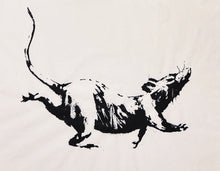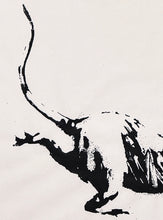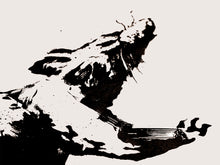‘GDP Rat’ by Banksy, 2018
Screen print handed out at random during Banksy's GrossDomesticProduct (GDP) show in Croydon, England.
Original owner collected this print himself on the last day of the GDP shop event.
15 x 20 Inches
38 x 51 Centimeters
26 x 32 x 2.2 Inches (framed)
One-color screen print on 52gsm matte newsprint paper.
Limited Edition (exact number unknown - but these are rare!).
Includes our gallery Certificate of Authenticity (see photos for additional proof of attendance.)
Very Good original condition (Fragile paper with minor natural ripples due to screen printing process).
*Note: Professionally double-matted and custom framed in acid-free black suede matting and UV-plexiglass in ornate gold hardwood molding.
ABOUT THE ART
Gross Domestic Product – The Homewares Brand from Banksy™ A carefully crafted publicity stunt or a genuine bid by Banksy to make his work more accessible?
In the Autumn of 2019, Banksy filled a shopfront in Croydon with a collection of new artworks and announced it on social media as his new venture, Gross Domestic Product. Fans flocked from all over the country to get their hands on his latest series of anti-establishment, irony-laden editions only to find that this was unlike any other store or gallery. Instead of entering the shop, buyers were directed to a website where they could register their interest and be entered into a lottery to win just one item, accompanied by a litany of terms and conditions.
A year before it opened, Banksy pulled off an incredible stunt that seemed to epitomize how he felt about the enormity of the secondary market for his art. As the hammer came down on one of his paintings, Girl With Balloon, at Sotheby’s London, a self destruct device was activated and the painting appeared to fall from its frame, only to be shredded as the audience looked on in horror and amusement. The artist later made a video revealing how he had installed the device, “in case it was ever put up for auction.”
Thanks to GDP, Banksy was back in the headlines with a shop of his own, bypassing auction houses, galleries and dealers to sell directly to his fans. In order to emphasize the message of accessibility, products can be bought by those on lower incomes for just £10. The website also bears a polite note to collectors hoping to make a quick profit: “Please refrain from registering at this time if you are a wealthy art collector”.
Banksy's disdain for the art market will hardly be news for fans of the street artist; from scathing depictions of auction houses, such as his 'Morons' prints to Instagram comments about the value of his work on the secondary market, he has been vocal about his opinions. Undoubtedly, his disdain centers on the capitalist basis of the art market.








































